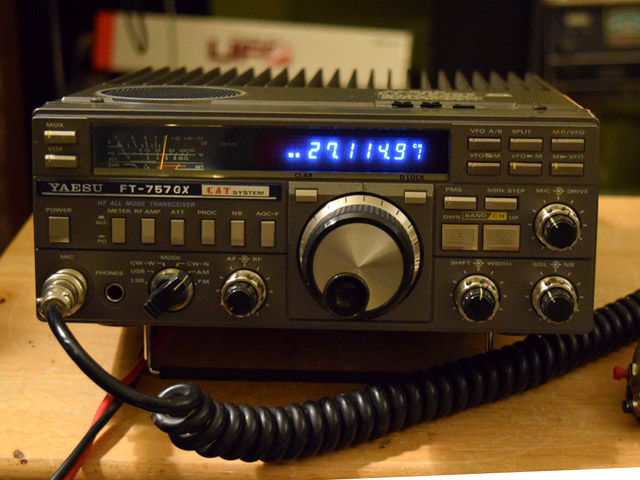

This is the Yaesu FT-757GX, all-mode amateur transceiver. This radio is an all solid state general coverage receiver and H.F. ham band transceiver. This was part of the "2nd generation" of general coverage radios (Radios like the Drake TR7, and Yaesu FT301 being the 1st generation), which now included all modes (Even F.M.). The '757 boasted many standard features, including digital dual VFO PLL tuning, memory channels, and split frequency operation, along with the usual standard features such as Volume, R.F. Gain, Mode switch, Carrier power, Variable noise blanker, and Variable bandwidth shift and width controls. Also, unlike many earlier H.F. radios, the '757 included a variable squelch control, which was most likely included due to the addition of the FM mode, which pretty much mandates a squelch. Other niceties included switchable attenuator, speech processor, and dual speed AGC action, as well as selectable meter functions. This was also one of the first radios to include a computer interface connection. By utilizing this interface (With the appropriate computer software), it would allow remote control of many functions via computer control.
This radio became a favorite among high performance 11 meter operators, mostly due to the ease at which it could be enabled for general coverage transmit (A simple flip of a microswitch, behind the front panel), which then allowed it to transmit anywhere it could receive (.5 - 30 Mhz). True to Yaesu form, the A.M. modulation was decent sounding on most microphones, although the speech processor needed to be kept on to keep the voice peaks from distorting. The 757 also sported a large, fairly linear, and easy to read, multi-function analog meter. Like most ham radios though, the 757's greatest advantage was to the SSB'er. Variable bandwidth, optional filters, and 100 watts of output with no tuning, were just what the doctor ordered in most cases.
I purchased mine new in 1984, and I still have it today. It still works for the most part. Although I noticed some drift from one of the oscillators, and it has another annoying problem where one of the PLL's does not lock when the rig is first turned on, and I have to cycle it on and off a few times before it finally locks. Someday when I get some time, I'll trace this down.....